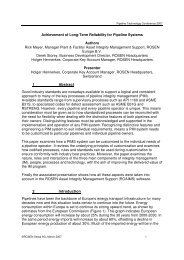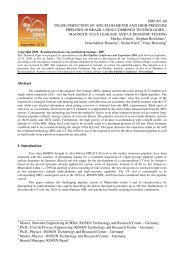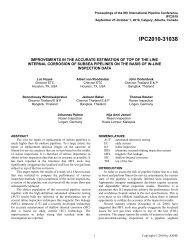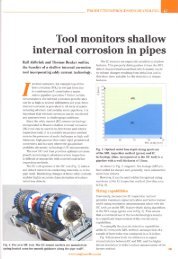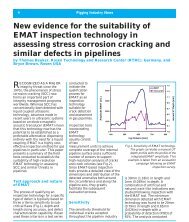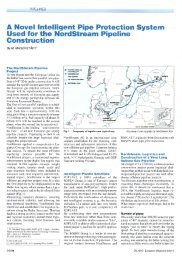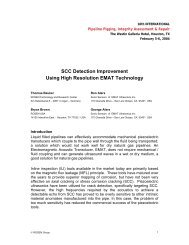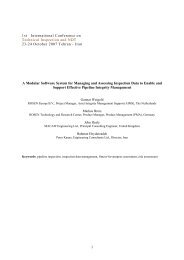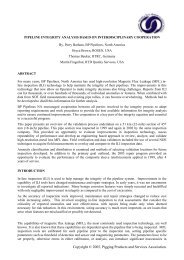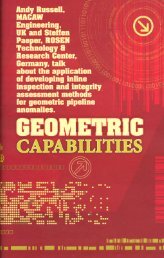in-line inspection of co2 pipelines - ROSEN Inspection Technologies
in-line inspection of co2 pipelines - ROSEN Inspection Technologies
in-line inspection of co2 pipelines - ROSEN Inspection Technologies
Create successful ePaper yourself
Turn your PDF publications into a flip-book with our unique Google optimized e-Paper software.
Document Name <strong>ROSEN</strong> CO2 - F<strong>in</strong>al Paper 01_20110614<br />
Revision Date 21-Sep-11<br />
Empowered by Technology<br />
www.rosen<strong>in</strong>spection.net<br />
the gas-phase. However, <strong>in</strong> these cases as well, the same applies as mentioned<br />
above, <strong>in</strong> that H2S or H2O impurities may lead to serious <strong>in</strong>terior pipel<strong>in</strong>e corrosion.<br />
In either case, it is recommended to perform a basel<strong>in</strong>e survey to allow monitor<strong>in</strong>g <strong>of</strong><br />
potential corrosion growth and determ<strong>in</strong>ation <strong>of</strong> the corrosion growth rate. To achieve<br />
accurate results, it is required to use the same <strong>in</strong>spection technology for the<br />
subsequent <strong>in</strong>spections.<br />
Although the dense CO 2 phase reacts like a liquid with regards to some <strong>of</strong> its physical<br />
properties, the application <strong>of</strong> liquid coupled UT is not possible with the required<br />
accuracy. The reason for this is the low acoustic impedance <strong>of</strong> the CO 2, which is due<br />
to the low velocity <strong>of</strong> sound and the strong dependency <strong>of</strong> velocity and density from<br />
temperature and pressure. A detailed analysis <strong>of</strong> the basic relationship has been<br />
presented by [COLINA ET AL. 2003].<br />
Therefore, the <strong>in</strong>spection method <strong>of</strong> choice is the well established MFL technology.<br />
This technology is <strong>in</strong>dependent from the medium, its pressure and temperature.<br />
Nowadays, it is possible to comb<strong>in</strong>e the MFL <strong>in</strong>spection device with a high-resolution<br />
geometry unit to ga<strong>in</strong> more <strong>in</strong>formation from a s<strong>in</strong>gle <strong>in</strong>spection survey. Figure 9<br />
shows a 24” ILI tool, where the front unit is equipped with the MFL technology, while<br />
the rear unit is dedicated to high-resolution geometry assessment. <strong>ROSEN</strong> has<br />
developed a technology for the detection and assessment <strong>of</strong> shallow <strong>in</strong>ternal<br />
corrosion (SIC) which can be added to the geometry unit. This eddy current based<br />
add-on is an additional <strong>in</strong>dependent methodology support<strong>in</strong>g the MFL f<strong>in</strong>d<strong>in</strong>gs and<br />
reduc<strong>in</strong>g the detection threshold for <strong>in</strong>ternal metal loss features to 0.8 mm depth. The<br />
eddy current sensor (figure10) delivers an accurate map <strong>of</strong> the <strong>in</strong>ternal pipel<strong>in</strong>e<br />
surface (figure11). The comb<strong>in</strong>ed technology delivers accurate results for the<br />
assessment <strong>of</strong> corrosion. The efficiency precision <strong>of</strong> the comb<strong>in</strong>ed evaluation has<br />
been described by [HUYSE ET AL. 2010].<br />
To derive reliable corrosion growth rates, a two tear process is suggested. At first, the<br />
reported anomalies from subsequent <strong>in</strong>spections are mapped aga<strong>in</strong>st each other.<br />
Secondly ,the normalized <strong>in</strong>spection signals are compared to compensate the<br />
systematic and random error from both runs. An example <strong>of</strong> such a comparison is<br />
given <strong>in</strong> figure 12. Data from three subsequent <strong>in</strong>spection surveys are shown. The<br />
signal pattern <strong>of</strong> a girth-weld can clearly be identified and is used for reference. The<br />
<strong>in</strong>dividual <strong>in</strong>spection report only gives the maximum depth <strong>of</strong> the corrosion area <strong>in</strong><br />
question. However, compar<strong>in</strong>g the raw ILI data clearly shows, that light corrosion is<br />
already present. This corrosion has not been reported, s<strong>in</strong>ce it was below the<br />
contractually agreed report<strong>in</strong>g threshold. Nevertheless, for the calculation <strong>of</strong> a<br />
corrosion growth rate and to better understand the mechanism <strong>of</strong> deterioration, the<br />
additional <strong>in</strong>formation drawn from the raw data is crucial.<br />
SUMMARY<br />
The current development <strong>of</strong> the carbon capture and storage (CCS) technologies is<br />
preceed<strong>in</strong>g the <strong>in</strong>spection <strong>of</strong> pipel<strong>in</strong>es transport<strong>in</strong>g CO 2. Because <strong>of</strong> its particular<br />
properties, the <strong>in</strong>spection <strong>of</strong> these pipel<strong>in</strong>es are lead<strong>in</strong>g to additional challenges for<br />
<strong>in</strong>spection companies.<br />
The critical properties <strong>of</strong> CO 2 transport<strong>in</strong>g pipel<strong>in</strong>es are the very dry conditions and<br />
the CO 2’s highly volatility as a solvent. The first is ma<strong>in</strong>ly abrasive to the driv<strong>in</strong>g and<br />
carry<strong>in</strong>g elements (PUR cups and disc) <strong>of</strong> an <strong>in</strong>spection tool, whilst the second has an<br />
Transportation <strong>of</strong> CO2 by Pipel<strong>in</strong>e page 6 <strong>of</strong> 12



